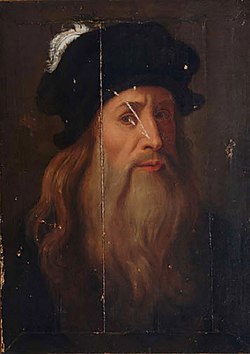Lucan portrait of Leonardo da Vinci
| Lucanian portrait of Leonardo da Vinci | |
|---|---|
 |
|
| Artist | Leonardo da Vinci (attributed) |
| Year | 1505–1510 |
| Medium | tempera grassa on wooden panel |
| Dimensions | 40 cm × 60 cm (17 in × 24 in) |
| Location | Museo delle Antiche Genti di Lucania, Vaglio Basilicata |
| Owner | Museo delle Antiche Genti di Lucania |
The Lucan portrait of Leonardo da Vinci is a late 15th or early 16th century portrait of a man that was recently discovered in a cupboard of a private house in Italy. It strongly resembles a portrait of Leonardo da Vinci held by the Uffizi Gallery and regarded by experts as a forgery. The painting was previously thought by its owners to represent Galileo but on its discovery in 2008 a claim was made that it is a self-portrait by Leonardo da Vinci.Alessandro Vezzosi, director of the Museo Ideale Leonardo da Vinci at Vinci said in 2011 that he had excluded the possibility that it was a self-portrait, but that the painting "remains intriguing because it adds a new element to the Leonardo puzzle".
Painted in tempera grassa on panel, 60 by 40 centimetres (24 in × 16 in) it depicts a man in three-quarter view, with a long beard and wearing a dark hat. It is currently exhibited in the Museo delle Antiche Genti di Lucania (Museum of the Ancient People of Lucania) in Vaglio Basilicata, a region of Southern Italy.
In 2008 Nicola Barbatelli, Director of the Museo, discovered the painting, attributed it to Leonardo, and gave it the name Lucan portrait, from Lucania, the ancient name of Basilicata. In 2010 a conference was held at which a team comprising David Bershad, Professor at University of Calgary (Canada), Peter Hohenstatt, Professor at the University of Parma, Felice Festa, Professor of Orthodontics and Gnathology at the University of Chieti, and Nicola Barbatelli, presented the findings in support of Barbatelli's attribution. No results of detailed stylistic analysis of the painting, or stylistic comparison with known works by Leonardo da Vinci or other possible authors are available, and it is unknown if such studies have taken place.
The painting was found in 2008 by Nicola Barbatelli, director of the Museo delle Antiche Genti di Lucania, in the private collection of an aristocratic family at Acerenza (population 3,000), a village on the river Bradano near Potenza in Basilicata. The family, who have asked to remain anonymous, believed it to be a portrait of Galileo. According to Professor Peter Hohenstatt of the University of Parma, the portrait is listed on page 116 of Napoli Antica e Moderna, (1815) edited by Abate Domenico Romanelli, as being the work of Leonardo da Vinci and located in the Palazzo Baranello nella strada Cedronia of the Duke of Baranello, of the noble family Russo.
...
Wikipedia
